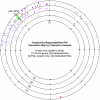Global proteomic analysis of two tick-borne emerging zoonotic agents: anaplasma phagocytophilum and ehrlichia chaffeensis
- PMID: 21687416
- PMCID: PMC3109344
- DOI: 10.3389/fmicb.2011.00024
Global proteomic analysis of two tick-borne emerging zoonotic agents: anaplasma phagocytophilum and ehrlichia chaffeensis
Abstract
Anaplasma phagocytophilum and Ehrlichia chaffeensis are obligatory intracellular α-proteobacteria that infect human leukocytes and cause potentially fatal emerging zoonoses. In the present study, we determined global protein expression profiles of these bacteria cultured in the human promyelocytic leukemia cell line, HL-60. Mass spectrometric (MS) analyses identified a total of 1,212 A. phagocytophilum and 1,021 E. chaffeensis proteins, representing 89.3 and 92.3% of the predicted bacterial proteomes, respectively. Nearly all bacterial proteins (≥99%) with known functions were expressed, whereas only approximately 80% of "hypothetical" proteins were detected in infected human cells. Quantitative MS/MS analyses indicated that highly expressed proteins in both bacteria included chaperones, enzymes involved in biosynthesis and metabolism, and outer membrane proteins, such as A. phagocytophilum P44 and E. chaffeensis P28/OMP-1. Among 113 A. phagocytophilum p44 paralogous genes, 110 of them were expressed and 88 of them were encoded by pseudogenes. In addition, bacterial infection of HL-60 cells up-regulated the expression of human proteins involved mostly in cytoskeleton components, vesicular trafficking, cell signaling, and energy metabolism, but down-regulated some pattern recognition receptors involved in innate immunity. Our proteomics data represent a comprehensive analysis of A. phagocytophilum and E. chaffeensis proteomes, and provide a quantitative view of human host protein expression profiles regulated by bacterial infection. The availability of these proteomic data will provide new insights into biology and pathogenesis of these obligatory intracellular pathogens.
Keywords: Anaplasma phagocytophilum; Ehrlichia chaffeensis; human granulocytic anaplasmosis; human leukocytes; human monocytic ehrlichiosis; proteomic analysis.
Figures









Similar articles
-
Intra-leukocyte expression of two-component systems in Ehrlichia chaffeensis and Anaplasma phagocytophilum and effects of the histidine kinase inhibitor closantel.Cell Microbiol. 2006 Aug;8(8):1241-52. doi: 10.1111/j.1462-5822.2006.00704.x. Cell Microbiol. 2006. PMID: 16882029
-
Divergent interactions of Ehrlichia chaffeensis- and Anaplasma phagocytophilum-infected leukocytes with endothelial cell barriers.Infect Immun. 2003 Dec;71(12):6728-33. doi: 10.1128/IAI.71.12.6728-6733.2003. Infect Immun. 2003. PMID: 14638757 Free PMC article.
-
Role and Function of the Type IV Secretion System in Anaplasma and Ehrlichia Species.Curr Top Microbiol Immunol. 2017;413:297-321. doi: 10.1007/978-3-319-75241-9_12. Curr Top Microbiol Immunol. 2017. PMID: 29536364
-
Molecular events involved in cellular invasion by Ehrlichia chaffeensis and Anaplasma phagocytophilum.Vet Parasitol. 2010 Feb 10;167(2-4):155-66. doi: 10.1016/j.vetpar.2009.09.017. Epub 2009 Sep 19. Vet Parasitol. 2010. PMID: 19836896 Free PMC article. Review.
-
Tick-Borne Emerging Infections: Ehrlichiosis and Anaplasmosis.Clin Lab Med. 2017 Jun;37(2):317-340. doi: 10.1016/j.cll.2017.01.006. Epub 2017 Mar 25. Clin Lab Med. 2017. PMID: 28457353 Review.
Cited by
-
Autophagosomes induced by a bacterial Beclin 1 binding protein facilitate obligatory intracellular infection.Proc Natl Acad Sci U S A. 2012 Dec 18;109(51):20800-7. doi: 10.1073/pnas.1218674109. Epub 2012 Nov 28. Proc Natl Acad Sci U S A. 2012. PMID: 23197835 Free PMC article.
-
Discovery of in vivo Virulence Genes of Obligatory Intracellular Bacteria by Random Mutagenesis.Front Cell Infect Microbiol. 2020 Feb 4;10:2. doi: 10.3389/fcimb.2020.00002. eCollection 2020. Front Cell Infect Microbiol. 2020. PMID: 32117791 Free PMC article.
-
Insights into the CtrA regulon in development of stress resistance in obligatory intracellular pathogen Ehrlichia chaffeensis.Mol Microbiol. 2011 Dec;82(5):1217-34. doi: 10.1111/j.1365-2958.2011.07885.x. Epub 2011 Nov 7. Mol Microbiol. 2011. PMID: 22014113 Free PMC article.
-
Ehrlichia type IV secretion system effector Etf-2 binds to active RAB5 and delays endosome maturation.Proc Natl Acad Sci U S A. 2018 Sep 18;115(38):E8977-E8986. doi: 10.1073/pnas.1806904115. Epub 2018 Sep 4. Proc Natl Acad Sci U S A. 2018. PMID: 30181274 Free PMC article.
-
Effector bottleneck: microbial reprogramming of parasitized host cell transcription by epigenetic remodeling of chromatin structure.Front Genet. 2014 Aug 14;5:274. doi: 10.3389/fgene.2014.00274. eCollection 2014. Front Genet. 2014. PMID: 25177343 Free PMC article. Review.
References
-
- Bakken J. S., Dumler S. (2008). Human granulocytic anaplasmosis. Infect. Dis. Clin. North Am. 22, 433–448 - PubMed
-
- Barnewall R. E., Ohashi N., Rikihisa Y. (1999). Ehrlichia chaffeensis and E. sennetsu, but not the human granulocytic ehrlichiosis agent, colocalize with transferrin receptor and up-regulate transferrin receptor mRNA by activating iron-responsive protein 1. Infect. Immun. 67, 2258–2265 - PMC - PubMed
-
- Borjesson D. L., Kobayashi S. D., Whitney A. R., Voyich J. M., Argue C. M., Deleo F. R. (2005). Insights into pathogen immune evasion mechanisms: Anaplasma phagocytophilum fails to induce an apoptosis differentiation program in human neutrophils. J. Immunol. 174, 6364–6372 - PubMed
Grants and funding
LinkOut - more resources
Full Text Sources
Other Literature Sources
Molecular Biology Databases

